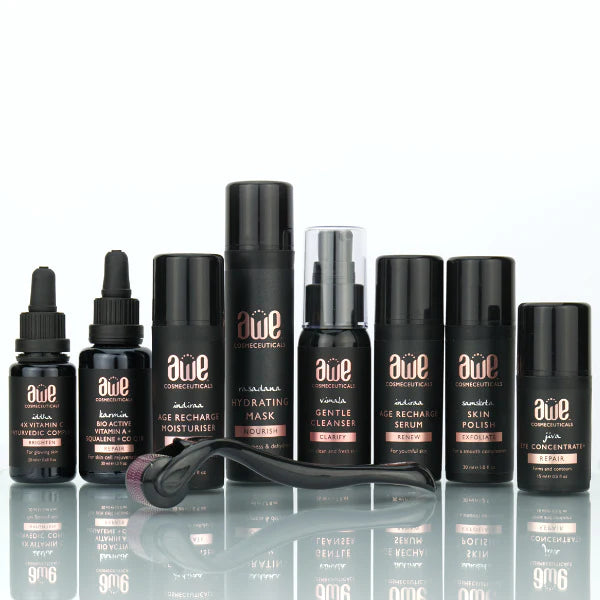This store requires javascript to be enabled for some features to work correctly.
Skin physiology
The skin is the largest organ of the body and as such requires nourishment and care. At AWE Cosmeceuticals™ we recognise that everyone's skin is unique. Individual skin chemistry has an impact on the effect a skin care product will produce. In particular, we use the Ayurvedic philosophy and understanding of Vata, Pitta and Kapha doshas to help classify skin disorders and the best treatments.
Your skin is made up of two main layers, the epidermis (upper/outer layer) and the thicker dermis, which forms most of the structure, with fibres such as collagen and elastin. The main cell in the dermis is called the fibroblast. The health of this cell directly impacts your ability to formulate new collagen.
The skin is a complex structure which is constantly changing at the upper levels. Did you know that the epidermal cells are continually being desquamated (shed), at an interval of approximately every 28 days?
Although the skin’s pH is typically slightly acidic, this will change depending on the constitution of your particular skin type. Variations in your skin can be due to influences of your internal biological changes such as, the ageing process and hormone levels, as well as external factors like your environment, climate, seasonal changes and lifestyle factors such as stress and diet.
All of these internal and external factors have the power to influence the natural balance of your skin.
Collagen is the major protein found in the skin. It is tough and fibrous, it is the primary constituent in collagenous connective tissue. Collagen is produced by fibroblasts (specialised cell). Unlike elastin, collagen is not intended to stretch, it provides the skin with tensile strength.
A skin care product containing biologically active ingredients, which have a physiological effect on the skin. The term ‘cosmeceutical’ was coined by dermatologist, Dr Albert Kligman nearly 30 years ago.
The dermis is the layer of the skin under the epidermis, it consists of two layers the reticular layer and the papillary layer. The papillary dermis is the upmost layer which is in contact with the epidermis; it contains some collagen and elastin fibres, lymphatic vessels, blood vessels and connective tissue cells. The reticular layer consists of fewer cells, however the bundles of collagen and elastin are much stronger and more fibrous. This is the layer of the skin which provides the most strength.
The process of desquamation involves the shedding of cells from the upper most layer of the skin, the stratum corneum. It is a very complex process which, if irregular can result in a number of skin conditions. Accelerated desquamation is most notable in skin disorders such as psoriasis.
A protein found in connective tissue. Elastin provides skin with its elastic quality of recoiling when stretched.
The epidermis consists of five different layers, each undergoing further changes and keratinisation as they leave the inner most layer, stratum basale, until they reach the outer most layer (stratum corneum), ready for desquamation. The epidermis is composed of keratinocytes, corneocytes and lahgerhans cells. The rate at which cells turn over to replace themselves is partly related to age. For example, a young person can have full renewal of the stratum corneum in as little as 14 days and up to over 35 days in those above age 50. Many skin conditions arise as a result of irregularity in this mechanism. The epidermis is constantly changing and what happens on the surface of the skin, will affect the dermis as these are essentially one unit.
A cell found in connective tissue, which produces connective tissue components such as, collagen and elastin.
This problem arises from the decrease in cellular desquamation of corneocytes and the increased cohesion of these cells. A number of factors may contribute to this condition.
This is a fibrous protein present in the corneocytes of the epidermis, hair and nails. As cells migrate upwards toward the outer layer, their keratin content increases, hence the name ‘keratinisation’. Keratin forms a protective barrier, due to its strong matrix structure.
A vesicle consisting of a lipid bi layer, it is designed to act as a carrier depositing an active ingredient into the skin. Liposomes are often made from naturally derived phospholipids and therefore cause no irritation and are not harmful.
A pigment formed in the melanocyte. It is a complex molecule of which the basic unit is an amino acid, tyrosine.
A cell which from which the skin pigment melanin is formed. The melanocyte provides pigment to approximately 35 keratinocytes. The association between the two is the epidermal melanin unit.
These glands are found all over the body, except for the palms of the hands and feet. The number and size of glands vary according to location on the body and the presence of hair follicles. The follicle has a sac like appearance and contains keratin cells, sebum and bacteria; the gland opens onto the skin via a pore (opening). Most pores are not visible, however some can be larger. Pores are always associated with either a sebaceous gland or a sweat gland. Sebaceous glands and their by products are implicated in the pathogenesis of acne.
An oily substance produced by the sebaceous gland. Secretion does vary with age and is hormonally related. Sebum itself does not provide any known benefit in regard to the skin’s acid mantle or moisturisation.
Positioned under the dermis, the subcutaneous layer consists chiefly of adipose cells, it is essentially fatty tissue.






